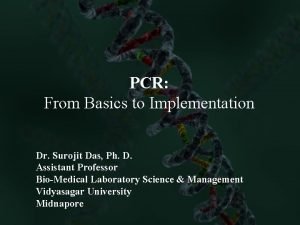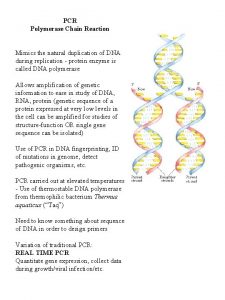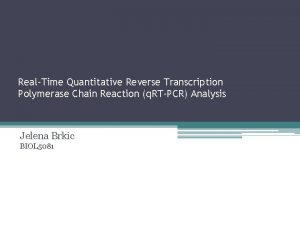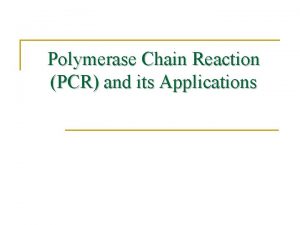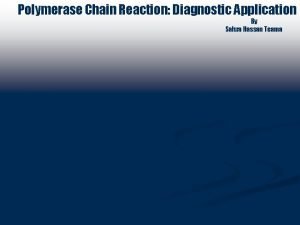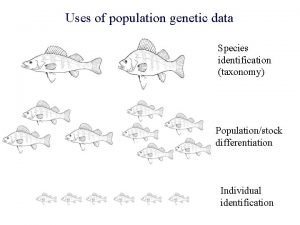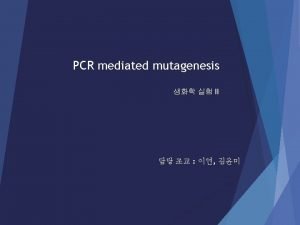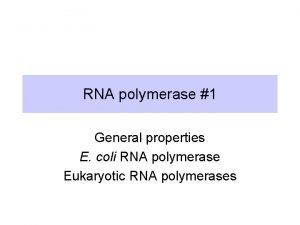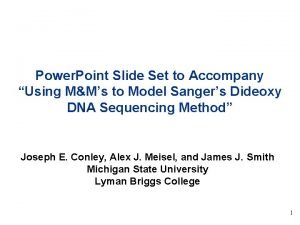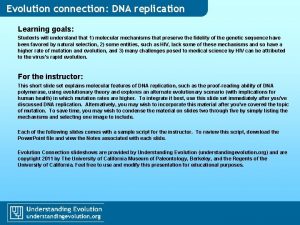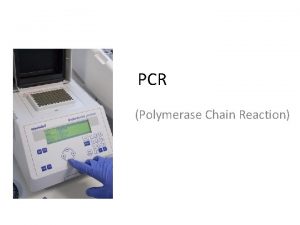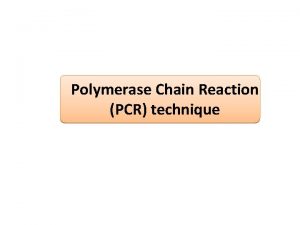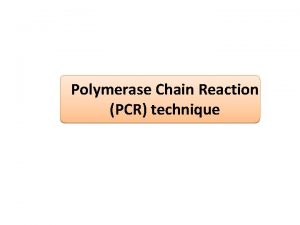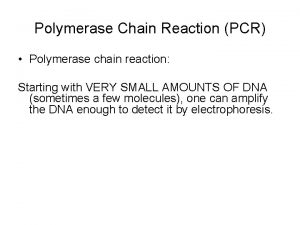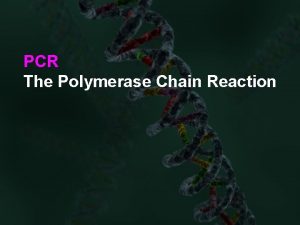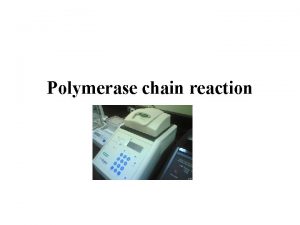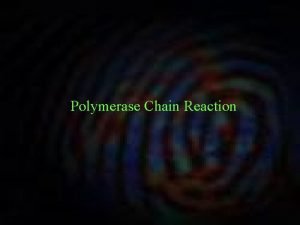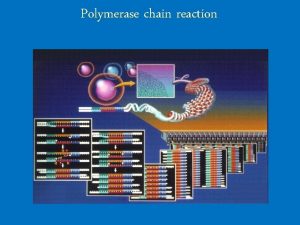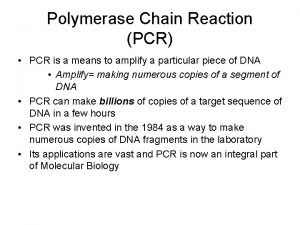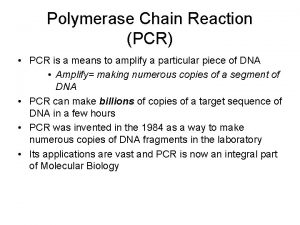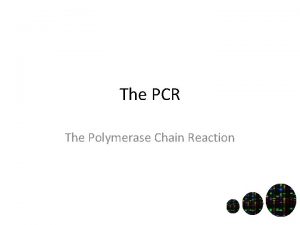Polymerase Chain Reaction PCR PCR is a means

















- Slides: 17

Polymerase Chain Reaction (PCR) PCR is a means to amplify a particular piece of DNA Amplify= making numerous copies of a segment of DNA PCR can make billions of copies of a target sequence of DNA in a few hours PCR was invented in the 1984 as a way to make numerous copies of DNA fragments in the laboratory

DNA Replication vs. PCR is a laboratory version of DNA Replication in cells The laboratory version is commonly called “in vitro” since it occurs in a test tube while“in vivo” signifies occurring in a living cell.

PCR The DNA, DNA polymerase, buffer, nucleotides, and primers are placed in a thinwalled tube and then these tubes are placed in the PCR thermal cycler PCR Thermocycler

The three main steps of PCR The basis of PCR is temperature changes and the effect that these temperature changes have on the DNA. In a PCR reaction, the following series of steps is repeated 20 -40 times Step 1: Denature DNA At 95 C, the DNA is denatured (i. e. the two strands are separated) Step 2: Primers Anneal At 40 C- 65 C, the primers anneal (or bind to) their complementary sequences on the single strands of DNA Step 3: DNA polymerase Extends the DNA chain At 72 C, DNA Polymerase extends the DNA chain by adding nucleotides to the 3’ ends of the primers.

Heat-stable DNA Polymerase Given that PCR involves very high temperatures, it is imperative that a heat-stable DNA polymerase be used in the reaction. Most DNA polymerases would denature (and thus not function properly) at the high temperatures of PCR. Taq DNA polymerase was purified from the hot springs bacterium Thermus aquaticus in 1976 Taq has maximal enzymatic activity at 75 C to 80 C, and substantially reduced activities at lower temperatures.

Denaturation of DNA This occurs at 95 ºC mimicking the function of helicase in the cell.

Step 2 Annealing or Primers Binding Reverse Primer Forward Primers bind to the complimentary sequence on the target DNA. Primers are chosen such that one is complimentary to the one strand at one end of the target sequence and that the other is complimentary to the other strand at the other end of the target sequence.

Step 3 Extension or Primer Extension extension DNA polymerase catalyzes the extension of the strand in the 5 -3 direction, starting at the primers, attaching the appropriate nucleotide (A -T, C-G)

The next cycle will begin by denaturing the new DNA strands formed in the previous cycle

The Size of the DNA Fragment Produced in PCR is Dependent on the Primers The PCR reaction will amplify the DNA section between the two primers. If the DNA sequence is known, primers can be developed to amplify any piece of an organism’s DNA. Forward primer Reverse primer Size of fragment that is amplified

The DNA of interest is amplified by a power of 2 for each PCR cycle For example, if you subject your DNA of interest to 5 cycles of PCR, you will end up with 25 (or 64) copies of DNA.

PCR has become a very powerful tool in molecular biology One can start with a single sperm cell or stand of hair and amplify the DNA sufficiently to allow for DNA analysis and a distinctive band on an agarose gel. One can amplify fragments of interest in an organism’s DNA by choosing the right primers. One can use the selectivity of the primers to identify the likelihood of an individual carrying a particular allele of a gene.

More about Primers PCR primers are short, single stranded DNA molecules (15 -40 bp) They are manufactured commercially and can be ordered to match any DNA sequence Primers are sequence specific, they will bind to a particular sequence in a genome As you design primers with a longer length (15 → 40 bp), the primers become more selective. DNA polymerase requires primers to initiate replication

Selectivity of Primers bind to their complementary sequence on the target DNA A primer composed of only 3 letter, ACC, for example, would be very likely to encounter its complement in a genome. As the size of the primer is increased, the likelihood of, for example, a primer sequence of 35 base letters repeatedly encountering a perfect complementary section on the target DNA become remote.

PCR and Disease Primers can be created that will only bind amplify certain alleles of genes or mutations of genes This is the basis of genetic counseling and PCR is used as part of the diagnostic tests for genetic diseases. Some diseases that can be diagnosed with the help of PCR: Huntington's disease Cystic Fibrosis Human immunodeficiency virus

PCR and Forensic Science Forensic science is the application of a broad spectrum of sciences to answer questions of interest to the legal system. This may be in relation to a crime or to a civil action. It is often of interest in forensic science to identify individuals genetically. In these cases, one is interested in looking at variable regions of the genome as opposed to highly-conserved genes. PCR can be used to amplify highly variable regions of the human genome. These regions contain runs of short, repeated sequences (known as variable number of tandem repeat (VNTR) sequences). The number of repeats can vary from 4 -40 in different individuals. Primers are chosen that will amplify these repeated areas and the genomic fragments generated give us a unique “genetic fingerprint” that can be used to identify an individual.

PCR Applications to Forensic Science Identifying badly decomposed bodies or when only body fragments are found - World Trade Center, Bosnian , Iraq & Rwandan mass graves
 Applications of polymerase chain reaction
Applications of polymerase chain reaction Polymerase chain reaction
Polymerase chain reaction Polymerase chain reaction
Polymerase chain reaction Polymerase chain reaction application
Polymerase chain reaction application Polymerase chain reaction uses
Polymerase chain reaction uses Polymerase chain reaction
Polymerase chain reaction The three steps of polymerase chain reaction
The three steps of polymerase chain reaction Food chain sequence
Food chain sequence Rna polymerase 1 2 3
Rna polymerase 1 2 3 Dna polymerase proofreading
Dna polymerase proofreading Dna primerase
Dna primerase Dna polymerase function in dna replication
Dna polymerase function in dna replication Helicaee
Helicaee Types of dna polymerase in eukaryotes
Types of dna polymerase in eukaryotes Types of dna polymerase in eukaryotes
Types of dna polymerase in eukaryotes Dna polymerase
Dna polymerase Rna polymerase
Rna polymerase Dna polymerase
Dna polymerase
